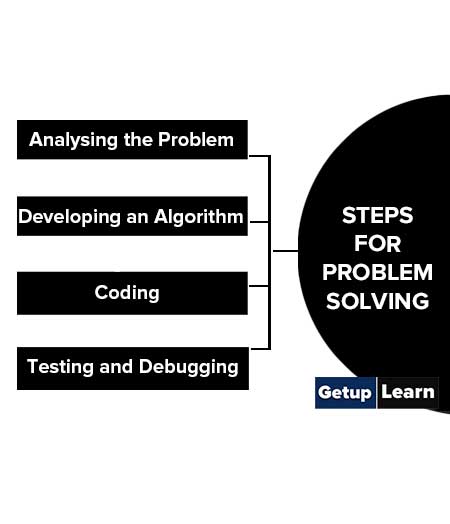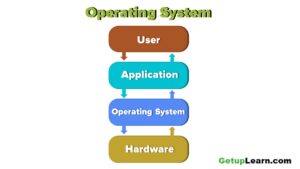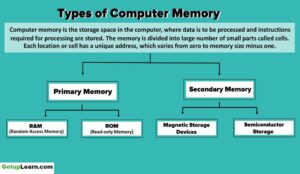Table of Contents
What is Problem Solving Algorithm?
Computers are used for solving various day-to-day problems and thus problem solving is an essential skill that a computer science student should know. It is pertinent to mention that computers themselves cannot solve a problem. Precise step-by-step instructions should be given by us to solve the problem.
Thus, the success of a computer in solving a problem depends on how correctly and precisely we define the problem, design a solution (algorithm) and implement the solution (program) using a programming language.
Thus, problem solving is the process of identifying a problem, developing an algorithm for the identified problem and finally implementing the algorithm to develop a computer program.
Definition of Problem Solving Algorithm
These are some simple definition of problem solving algorithm which given below:
[su_quote cite=””]Algorithms are the solutions to computational problems. They define a method that uses the input to a problem in order to produce the correct output. A computational problem can have many solutions.[/su_quote]
[su_quote cite=””]An algorithm is defined as a step-by-step procedure designed to perform an operation which will lead to the desired result, if followed correctly.[/su_quote]
[su_quote cite=””]Algorithms have a definite beginning and a definite end, and a finite number of steps. A good algorithm, which is precise, unique and finite, receives input and produces an output.[/su_quote]
[su_quote cite=””]A set of sequential steps usually written in Ordinary Language to solve a given problem is called Algorithm.[/su_quote]
Steps for Problem Solving
When problems are straightforward and easy, we can easily find the solution. But a complex problem requires a methodical approach to find the right solution. In other words, we have to apply problem solving techniques.
Problem solving begins with the precise identification of the problem and ends with a complete working solution in terms of a program or software. Key steps required for solving a problem using a computer.
For Example: Suppose while driving, a vehicle starts making a strange noise. We might not know how to solve the problem right away. First, we need to identify from where the noise is coming? In case the problem cannot be solved by us, then we need to take the vehicle to a mechanic.
The mechanic will analyse the problem to identify the source of the noise, make a plan about the work to be done and finally repair the vehicle in order to remove the noise. From the example, it is explicit that, finding the solution to a problem might consist of multiple steps.
Following are Steps for Problem Solving:

Analysing the Problem
It is important to clearly understand a problem before we begin to find the solution for it. If we are not clear as to what is to be solved, we may end up developing a program which may not solve our purpose.
Thus, we need to read and analyse the problem statement carefully in order to list the principal components of the problem and decide the core functionalities that our solution should have. By analysing a problem, we would be able to figure out what are the inputs that our program should accept and the outputs that it should produce.
Developing an Algorithm
It is essential to device a solution before writing a program code for a given problem. The solution is represented in natural language and is called an algorithm. We can imagine an algorithm like a very well-written recipe for a dish, with clearly defined steps that, if followed, one will end up preparing the dish.
We start with a tentative solution plan and keep on refining the algorithm until the algorithm is able to capture all the aspects of the desired solution. For a given problem, more than one algorithm is possible and we have to select the most suitable solution.
Coding
After finalising the algorithm, we need to convert the algorithm into the format which can be understood by the computer to generate the desired solution. Different high level programming languages can be used for writing a program. It is equally important to record the details of the coding procedures followed and document the solution. This is helpful when revisiting the programs at a later stage.
Testing and Debugging
The program created should be tested on various parameters. The program should meet the requirements of the user. It must respond within the expected time. It should generate correct output for all possible inputs. In the presence of syntactical errors, no output will be obtained. In case the output generated is incorrect, then the program should be checked for logical errors, if any.
Software industry follows standardised testing methods like unit or component testing, integration testing, system testing, and acceptance testing while developing complex applications. This is to ensure that the software meets all the business and technical requirements and works as expected.
The errors or defects found in the testing phases are debugged or rectified and the program is again tested. This continues till all the errors are removed from the program. Once the software application has been developed, tested and delivered to the user, still problems in terms of functioning can come up and need to be resolved from time to time.
The maintenance of the solution, thus, involves fixing the problems faced by the user, answering the queries of the user and even serving the request for addition or modification of features.
Representation of Algorithms
Using their algorithmic thinking skills, the software designers or programmers analyse the problem and identify the logical steps that need to be followed to reach a solution. Once the steps are identified, the need is to write down these steps along with the required input and desired output.
There are two common methods of representing an algorithm —flowchart and pseudocode. Either of the methods can be used to represent an algorithm while keeping in mind the following:
- It showcases the logic of the problem solution, excluding any implementational details.
- It clearly reveals the flow of control during execution of the program.
Flowchart
A flowchart is a visual representation of an algorithm. A flowchart is a diagram made up of boxes, diamonds and other shapes, connected by arrows. Each shape represents a step of the solution process and the arrow represents the order or link among the steps.
A flow chart is a step by step diagrammatic representation of the logic paths to solve a given problem. Or A flowchart is visual or graphical representation of an algorithm.
The flowcharts are pictorial representation of the methods to b used to solve a given problem and help a great deal to analyze the problem and plan its solution in a systematic and orderly manner. A flowchart when translated in to a proper computer language, results in a complete program.
Advantages of Flowcharts:
- The flowchart shows the logic of a problem displayed in pictorial fashion which felicitates easier checking of an algorithm
- The Flowchart is good means of communication to other users. It is also a compact means of recording an algorithm solution to a problem.
- The flowchart allows the problem solver to break the problem into parts. These parts can be connected to make master chart.
- The flowchart is a permanent record of the solution which can be consulted at a later time.
Differences between Algorithm and Flowchart
| S.No. | Algorithm | Flowchart |
| 1 | A method of representing the step-by-step logical procedure for solving a problem. | Flowchart is diagrammatic representation of an algorithm. It is constructed using different types of boxes and symbols. |
| 2 | It contains step-by-step English descriptions, each step representing a particular operation leading to solution of problem. | The flowchart employs a series of blocks and arrows, each of which represents a particular step in an algorithm. |
| 3 | These are particularly useful for small problems. | These are useful for detailed representations of complicated programs. |
| 4 | For complex programs, algorithms prove to be Inadequate. | For complex programs, Flowcharts prove to be adequate. |
Pseudo code
The Pseudo code is neither an algorithm nor a program. It is an abstract form of a program. It consists of English like statements which perform the specific operations. It is defined for an algorithm. It does not use any graphical representation.
In pseudo code, the program is represented in terms of words and phrases, but the syntax of program is not strictly followed.
Advantages of Pseudocode
- Before writing codes in a high level language, a pseudocode of a program helps in representing the basic functionality of the intended program.
- By writing the code first in a human readable language, the programmer safeguards against leaving out any important step. Besides, for non-programmers, actual programs are difficult to read and understand.
- But pseudocode helps them to review the steps to confirm that the proposed implementation is going to achieve the desire output.












